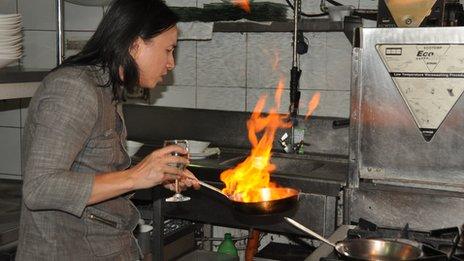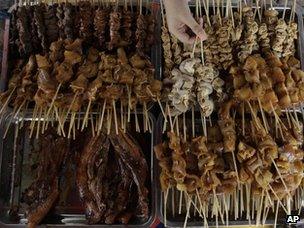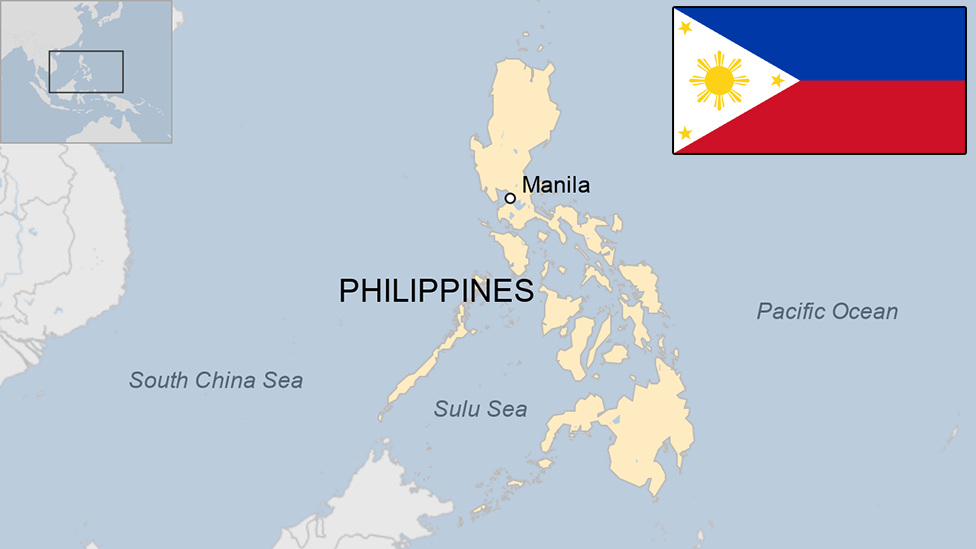Philippine chefs look to take national cuisine mainstream
- Published

Chefs like Rolando Laudico are experimenting with traditional recipes in a bid to make Philippine food more well-known
In Thailand, India, Malaysia, Japan - in fact, in almost every country in Asia - there is a distinctive, internationally acclaimed cuisine.
The Philippines though, is a rare exception. While Filipinos love their food, few foreigners have tasted or even heard of the country's signature dishes like adobo, sinigang, lumpia and pancit.
It is a situation that chef Rolando Laudico is desperate to change.
"Philippine food is as rich and varied as other Asian cuisine - even more so," he says confidently, as he sits by the window of his chic restaurant in the heart of Fort Bonifacio, Manila's new business district.
With his long hair and personally-designed outfit, Mr Laudico is one of a new generation of chefs determined to bring Philippine food to a wider audience.
He and his wife, Jackie, run Bistro Filipino, a restaurant that serves a modern take on the national cuisine.
"We base our flavours on traditional Philippine flavours, and we get inspired by them. We innovate, we do our own style, and we make it accessible for foreigners," he says.
He is especially proud of his version of lumpia - a spring roll made with coconut palm. It is usually seen as a starter or street food, but the Laudicos have reduced the amount of oil and turned the roll into a cone.
"It's traditionally eaten with vinegar, but we've turned it into iced vinegar, so when you eat it in the restaurant, it's more refined, less messy," he said.
Mr Laudico believes the reason why Philippine food is not well-respected is because Filipinos themselves do not respect it. They might like to eat it, but they do not think others will.
"We have a lack of pride in our own cuisine," he explained. "For hundreds of years, when we've had guests in our homes, we've apologised and said to them: 'I'm very sorry, I can only serve you Philippine food'."
Image problem
But the Laudicos - and increasingly others like them - face a tough battle in trying to change the perception of Philippine cuisine from cheap, everyday fare into a flavourful, varied cuisine.
"When we first opened six years ago, even our chef friends were surprised we were opening a Philippine restaurant. They said: 'Who will pay more than 500 pesos ($12, £7) to eat Philippine food?"
And it is not just perception inside the country that is the problem. Philippine food also has an image problem abroad.
If it is known at all, an oft-heard criticism is that it is a bit too oily, a bit too sweet and, frankly, a bit too strange.
Balut, for example, might look like a normal egg on the outside, but as soon as you crack it open, you will see a fully-formed duck foetus. Eating it is not for the faint-hearted.
Then there is isaw - barbecued pig or chicken intestines on a stick - and the wonderfully named betamax or cubes of dried chicken blood which look a bit like old video tapes.
And on first glance, a visitor to the Philippines might well assume the national dish is fast food. Burger joints, pizza chains and fried chicken outlets are on almost every street corner.
'Lifetime to discover'
But delve a bit deeper and Philippine cuisine has a wonderful array of textures and flavours, something chef Gene Gonzalez is on a mission to publicise.
"What's unique about Philippine food is that it's got so many facets," he says, with an almost evangelical zeal.
"You've got the ethnic tribal styles, you've got the Spanish colonial style, you've got the Chinese and Malay influences, and then you've got the city style that's evolved from all of that.
"Put it together, and multiply it by our 7,107 islands, each of which have their own specialties, and it'll take a lifetime to discover Philippine cuisine."
Mr Gonzalez owns a restaurant, Cafe Ysabel, in a beautiful colonial-era house in central Manila.
Most of his dishes are the usual restaurant fare of pasta and pizza, but there is a section of more traditional options, cooked the same way as when the Philippines was a Spanish colony.
It is clearly the love and not the economics that is behind this section of the menu - the Italian food seems a clear favourite among diners, who are more accustomed to eating Philippine food at home and foreign food when they go out.
Mr Gonzalez has adopted the same approach to his cooking school, the Centre for Asian Culinary Studies.
Most of the dishes he teaches are Western or international in origin, acknowledging the fact that his pupils will probably be employed in kitchens that specialise in foreign food, and many will work in foreign countries as part of the huge network of Philippine migrant workers.
But he is determined to put at least some Philippine favourites into his training course.
"Filipinos are known to be global chefs, and we create the Philippine global chef. But part of our curriculum is to teach Filipinos how to cook Philippine cuisine, and it's imperative we do this," he said.
'Evolution'
Mr Gonzalez has a receptive audience in his students. Becoming a chef is one of the most popular professions in the Philippines right now - many dream of cooking their way to success.
While not many envisage making a living from cooking Philippine food, every Filipino I have ever met loves their national cuisine, and given enough encouragement would be only too eager to share it with others if they thought there was a market for it.

Some foreigners may find Philippine food such as isaw intimidating
It is the early days yet, but the young pioneers who have already decided to take the risk - and hope that a market is there - seem to be succeeding.
The Laudicos' Bistro Filipino is packed most nights, and the couple opened another outlet last year because of the demand.
They even count Imelda Marcos - widow of former President Ferdinand Marcos and a woman known only too well for her upmarket tastes - among their satisfied customers.
Dr Alex Orquiza, a historian at Wellesley College and an expert on the heritage of Asian food, believes Philippine cuisine has been ignored for much too long, and applauds efforts at modernisation.
"Contemporary chefs are simply adding to a long series of development and evolution that is natural, considering the archipelago's location and function as a trade centre," he says.
So perhaps the time will soon come, with a mixture of modernising and marketing, when Philippine cuisine can join other Asian foods on the international stage.
- Published5 July 2023
